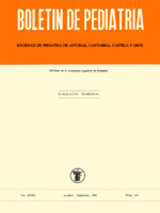Artritis reactiva asociada a meningitis por Haemophilus influenzae
E. Sierra Pérez , V. Nebreda Pérez , E. García Jiménez , N. Burguillo Jiménez , P. Cuadrado Bello
Bol. Pediatr. 1991; 32 (142): 331 - 335
Se presenta un caso de artritis reactiva secundaria a meningitis por Haemophilus influenzae en una niña de 7 meses. Presentó artritis en articulación metararso-falángica del 1º dedo del pie izquierdo y de ambas caderas, que cedieron en el curso del tratamiento. Al 13º día con LCR normal persistía la fiebre y comenzó con artritis de rodilla izquierda que evolucionó favorablemente tratada exclusivamente con aspirina. En la literatura revisada se pone de manifiesto la dificultad en diferenciar artritis sépticas y reactivas. La persistencia de la fiebre es un hecho que se produce en ambos casos. El inicio precoz y la positividad de! hemocultivo harían pensar estadísticamente en artritis séptica. Sin embargo si exceptuamos la tinción de Gram y cultivo de! líquido sinovial, no existe ningún parámetro clínico o analítico que sea concluyente para el diagnóstico diferencial.
Reactive arthritis associated with Haemophilus influenzae meningitis
We report the case of a seven month old girl who developped reactive arthritis secondary to Haemophilus Influenzae meningitis. During the course of her meningeal picture, she showed arthritis of the metatarso-phalangeal joint of the first left toe, and both hips. It cleared with the antimicrobial therapy applied. On her 13th hospital day when the cerebrospinal fluid was normal, the fever continued and arthritis of the left knee was observed. Aspirin was able to solve this complication, without any further antibiotics. We reviewed the literature that emphasizes the difficulties to distinguish between septic and reactive arthritis, because persistent fever can occur in both conditions. Early onset and positive blood cultures are more common in septic arthritis. Nevertheless no clinical or laborarory data, except the demonstration of the organism in the sinovial fluid, either by Gram stain or by culture, can be used to make a firm differential diagnosis.
Artículo completo (PDF) (275 kb.)
- Infectología
